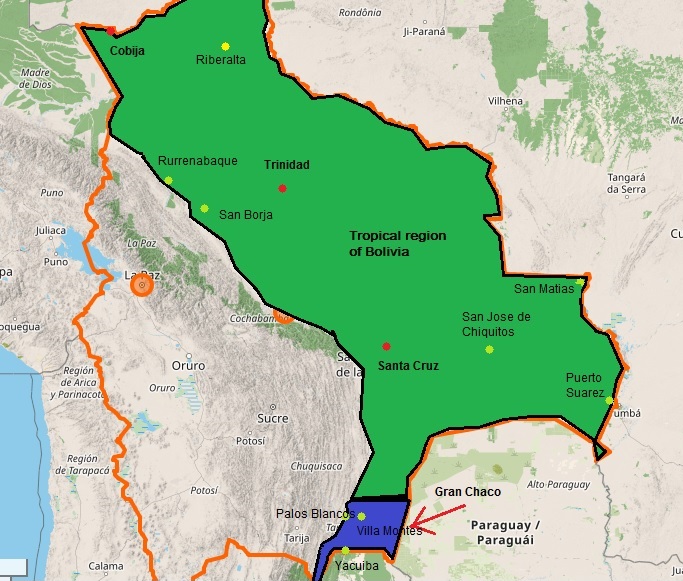Bolivia is indeed mostly a tropical country, located very near to the Amazonas. It’s a misconception that Bolivia is only cold and Altiplanic, as most of its people live in warm areas where temperatures during the day normally reach 90°F (32°C), and don’t drop at night below 72°F (22°C). In some places, temperatures can go up to 110°F (43°C).
The hottest places in Bolivia are 1) the Gran Chaco region, in the south of the country, and all its towns and rural areas, including Villa Montes, with temperatures of 105°F (40°C), but sometimes up to 110°F (43°C); and 2) the tropical western of the country, with about 100°F to 105°F (38°C to 40°C).
Here, we’ll be talking about the 7 hottest places in Bolivia, with all the details about their max temperatures during the day, at night, and at which time of the year, among other information. You’ll also know why these hot temperatures occur, the reasons they are so high, and why they happen at the end of the year.
Which is the hottest place in Bolivia?
In Bolivia, the hottest places are located on its tropical western side, where you can find tropical rainforests, tropical monsoons, and tropical savannas (the hottest place in the country) which appear to be Amazonian lands, but a little bit dryer. This is why this part of Bolivia is so hot, and comprehends more than 40% of the Bolivian territory.
The Gran Chaco is the hottest place in Bolivia
The hottest place in Bolivia is currently located in the Gran Chaco (in the very south of the country), where towns and rural places can sometimes reach up to 110°F (43°C), but most of the time they will be around 105°F (40°C) in a sunny day, particularly from October to January. This region of Bolivia contains towns like:
- Villa Montes
- Yacuiba
- Bermejo
- Palos Blancos
- Entre Rios
- And many other small towns
- No large cities
The tropical region of Bolivia is just 2°F to 5°F colder
Other large places also can become very hot, but they are not inside the Gran Chaco. These areas are located in the western, northwestern, and northern parts of Bolivia, including places and cities like:
- Puerto Suarez
- San José de Chiquitos
- Robore
- San Matias
- The Chiquitania
- Rurrenabaque
- San Borja
- Part of Madidi National Park
- Santa Cruz (the largest city in Bolivia)
- Trinidad
- Cobija
- Riberalta
In these places, tourist areas and towns, you’ll experience temperatures of 90°F (32°C) during the day, with peaks of 100°F to 105°F (38°C to 40°C). At night, they won’t drop below 72°F (22°C).

Heat strokes are a real possibility in all these places and you need to take all the needed precautions, particularly from September to April when temperatures go even hotter.
Warning: Chagas Disease
You must be very careful in all these regions, as you are at risk of “Chagas disease“, which is a deadly illness that damages your heart and doesn’t have a cure. It’s endemic in these regions (in the Gran Chaco, in Tarija, 48% of the population carry this parasite).
If you think that Santa Cruz is safer in this aspect, well that’s not the case. In Santa Cruz, 22% of the population has Chagas.
You should always look for living spaces that are fully plastered, without any cracks, and also take other precautions. Be very cautious!
The top 7 hottest places in Bolivia
1) Villa Montes town
The Villa Montes town, at the very south of Bolivia in the Tarija department, more specifically in the Gran Chaco region, is certainly one of the hottest urban areas that exist in the country, it gets very hot between September and April every year, the hottest season in the country, but by far the hottest months are October to January.
This town has the unique feature of having recorded the hottest-ever official temperature in Bolivia, which was 110.5°F (43.6°C) and happened in February 2016. Also, it normally has temperatures around 105°F (40°C) from October to January and above 95°F (35°C) in September, February and April. The rest months are colder.
This town is inside the Tarija department, in the very south of Bolivia, inside the Gran Chaco region, an arid tropical flat savannah also called the stove of South America. Villa Montes is not commonly visited by tourists and foreigners, and beyond its high temperatures, it’s just a normal town in Bolivia.
Remember to always be careful with the possibility of heat strokes when you are staying in this town or towns around, as temperatures of 105°F (40°C) are normally there at the end of the year. Take all the necessary precautions.
2) The Bolivian Chaco
The Bolivian Chaco is part of the Gran Chaco region, which consists of some parts of Argentina, Paraguay, and Bolivia. This region is really hot particularly from October to January, and also very arid with no rain at all during the middle of the year.
Image: The Gran Chaco
This land in the very south of Bolivia is characterized by having almost no rainfall from May to August, with a pretty hot climate, but it gets hotter with more rain at the end of the year, almost every day reaching temperatures of 105°F (40°C). In rural areas, this heat can be even deadly, as no health and care support is placed around.
Many towns that turn very warm are located inside the Gran Chaco on its Bolivian side, including:
- Villa Montes
- Yacuiba
- Bermejo
- Palos Blancos
- Entre Rios
- And many other small towns
This land is filled by agriculture and people that own land and work in these rural areas, they know how to live there and how to stay well against the really hot and in many cases very arid climates. Tourists don’t really go to the Gran Chaco region and its towns on the Bolivian side, also there are no important tourist places located there.
In this land always be careful of the high temperatures from September to April. You can experience the possibility of heatstroke, above 107°F (41°C), along with sudden droughts and desert-like landscapes.
2) Puerto Suarez town
This is a small town located in the eastern part of the Santa Cruz department, in the frontier between Bolivia and Brazil. This region is tropical and very close to the climatic features of the Amazonian rainforest. So, you would expect to experience a lot of heat all year long, but more in the hot season in the country, from September to April.
During the day, Puerto Suarez is almost always around 86°F to 95*F (30°C to 35°C) all year long, but from October to January, it can reach temperatures of 106°F (41°C) on some days. At night, temperatures can be around 73°F (23°C) and from October to January they will stay around 79°F (26°C) and won’t go below these hot levels.
Anyway, this town is not really visited by tourists, as it doesn’t have much to offer, is more like a commercial urban area that serves as a frontier gateway between Brazil and Bolivia and remembers the old days when the Tamengo canal, which mostly surrounds this town, was important and navigable.
Be always careful at the end of the year with possible heat strokes and similar issues in this town and nearby places.
4) The eastern part of the Santa Cruz department
At the very east of Bolivia, on the eastern side of the Santa Cruz apartment, there is a flat tropical area that gets a little bit warmer than the rest of the western tropical areas inside the country. This is because this area is closer to the Amazonian rainforest and is located deeper in the equatorial region of the continent.
Image: the eastern part of Bolivia
Many towns and some tourist places that have high temperatures all year long are located in this part of Bolivia:
- Puerto Suarez
- San José de Chiquitos
- Robore
- San Matias
- The Chiquitania
What is normal to see in all these towns, as we just mentioned about Puerto Suarez, are temperatures of about 106°F (41°C) on the hottest days.
Nevertheless, this part of the tropical region of Bolivia, consisting of Santa Cruz city and the surrounding areas, just gets a little bit colder, more precisely 2°F (1°C) colder, as these urban areas can reach temperatures of about 104°F (40°C) on the hottest days.
5) Rurrenabaque town
This is a well-known tourist town in Bolivia, it’s called the gate of Madidi Park, but it’s also very hot. These hot temperatures are present because this city is located over a wet and hot tropical land, close in location to the Amazonas, so you can imagine how hot this place can be all year long.
Rurrenabaque and the places and towns around experience high temperatures throughout the whole year, averaging about 90°F (32°C), but some days, mostly from September to April, up to 105°F (40°C). It’s also a very rainy place. Tropical rain storms are common at the end of the year.
Rurrenabaque is a pretty hot place as it has and enjoys an Amazonian climate, although it’s not in the Amazonian region, it’s one of the warmest and most rainy places in the country. When visiting this place, be careful with the possibility of heat strokes.
6) Central part of Beni and La Paz departments
This region of Bolivia, right above the center of the country, is classified as a tropical rainforest (af), so it exhibits an Amazonian climate, with more than 2,000 mm of annual rainfall each year, also with temperatures that are about 90°F (32°F) all year long that can reach in some cases 105°F (40°C).
Image: the central part of Bolivia
Some well-known towns and tourist places are located in this part of the country:
- Rurrenabaque
- San Borja
- Part of Madidi National Park
The hot temperatures there don’t fall at any moment and are almost permanent, with some drops of about 10°F (5°C) on some days in the middle of the year. Also at night, it’s very unlikely to have less than 77°F (25°C) at any moment, this hot weather doesn’t change too much and is permanent in this region.
7) Santa Cruz, Trinidad and Cobija cities
Also, large tropical cities of Bolivia can get very hot, showing average temperatures of 88°F (31°C) during the day, rarely dropping below 72°F (22°C) at night. In these cities on some days, temperatures can reach 105°F (40°C) at the end of the year.
Image: the largest tropical cities
These important and well-known tropical urban areas are:
- Santa Cruz (the largest city of Bolivia, 1,500,000 pop.)
- Trinidad (131,000 pop.)
- Cobija (65,000 pop.)
- Riberalta (in Pando department, 37,000 pop.)
Look for example at Santa Cruz, the largest city of Bolivia. There, particularly from October to February you’ll have some days with about 100°F to 105°F (38°C to 40°C). During these days heat strokes are a real concern, so be careful during these months when you are in this city or the cities within the tropical region of the country.
The other cities in the above list are also very hot, even hotter than Santa Cruz, and can reach 105°F (40°C) at the end of the year, but temperatures don’t drop too much the rest of the year, this is because all these cities are located at the tropical eastern of Bolivia, which occupies more than 40% of the country’s territory.
Which is the hottest time of the year in Bolivia?
As you’ve seen throughout this note, in Bolivia the hottest time occurs at the end of the year, between September and April, and gets even hotter between October and January. This is because spring and summer happen during these months in the country. These are wetter and hotter seasons in the whole Bolivian territory.
We have a complete guide about the hottest period of the year in the country, with all the numbers about the temperatures and places involved, the following direction: The hottest time in Bolivia, all you need to know.
Conclusions:
In this guide about the hottest places in Bolivia, you’ve seen that 2 regions inside the country contain all the hottest towns, tourist places, and rural areas you can encounter in Bolivia. These 2 regions are the Gran Chaco and the tropical eastern part of the country.
You now know that in Gran Chaco, the highest ever recorded temperature in Bolivia has happened in the Villa Montes town, with 110.5°F (43.6°C) in February 2016, indeed, this town is the hottest place in Bolivia. But you also know that all the towns in the Gran Chaco, like Yacuiba, Bermejo etcetera will have almost the same warm weather, with temperatures around 105°F (40°C), which become common from May to August.
You’ve learned that there is another region at the very east of Bolivia, close to the Brazilian rainforest and the Amazonas, where towns like Puerto Suarez, San Jose de Chiquitos, Robore, San Matias, etcetera, reach very high temperatures all year long, averaging about 72°F (32°C), but up to 100°F to 105°F (38°C to 40°C) in some days, this is because of the tropical rainforests that exist there.
Finally, you realized that very large cities like Santa Cruz, Trinidad and Cobija among others, together containing more than 2 million people, get also very hot all year long, but mostly at the end of this, with on average 88°F (31°C), and reaching up to 100°F to 105°F (38°C to 40°C) in a sunny day. Remember to always take all the precautions to avoid heat strokes in these places, cities, and regions of Bolivia.
We hope this information has helped you, and if you want to know every detail about the climate in Bolivia, including other places with very warm climates, visit our definitive guide in the following direction: How is the climate in Bolivia? A complete overview.
BolivianExperts.com, information about how to live, work, invest, and travel in Bolivia.








